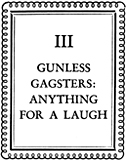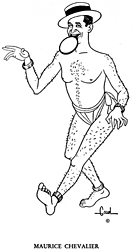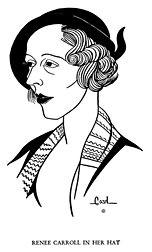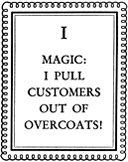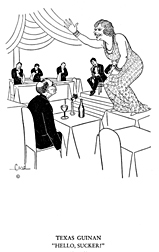Here’s Chapter 4 of In Your Hat, the 1933 tell-all memoir by Hat Check Girl to the Stars, Renee Carroll, in which she dishes on such 1930s luminaries as Claudette Colbert, Miriam Hopkins, Ernst Lubitsch, Clara Bow, and Douglas Fairbanks.
By the way, the Lubitsch movie Carroll refers to in this chapter, the one co-starring Maurice Chevalier, Miriam Hopkins, and Claudette Colbert, is The Smiling Lieutenant (1931), which New Yorkers (and those willing to travel) can see on the big screen as part of Film Forum’s Hollywood on the Hudson series on Tuesday, August 3rd. It’s paired on a double-bill that night with Laughter (1930), which, as it happens, stars Nancy Carroll, about whom a story is told later in the chapter.

A LOT of dirt gets swept by my little booth in conversational blobs that can’t stand light from the printed page, but at the same time I frequently pick up little stories that’ll bear repeating.
I don’t say I chum around with Broadway’s best, but I know most of the crowd by their given names and I’m usually calling a spade a spade even if it’s Bill Robinson. What I crave most is respect because nowadays that’s all a girl gets that doesn’t draw interest.
But now and then somebody whispers a yarn that’ll stand repeating, and chum or no chum, it has to be given up, which reminds of the time Herr Ernst Lubitsch (the little man with the big cigar) was directing a picture at the Paramount New York studio in Astoria.
It happened that Claudette Colbert, she of the extraordinary limbs, and Miriam Hopkins, who is now a Paramount star, were in a picture together with Maurice Chevalier.
In the story Chevalier is supposed to be married to Miriam, but because she is more or less of an ugly duckling, he is particularly fond of the more comely Claudette. The story develops to the point where Claudette is caught by Miriam in her own house. It develops into a verbal bout and then rapidly into a slapping match in which both girls are supposed to slap each other, cry a bit, and then make up. The slaps, like most of the blows in pictures, were supposed to have been pulled punches. But were they? Oh boy, no! And behind that is something of a story.
It happened that in the making of the picture Herr Lubitsch became more or less attached to the luminous blonde Miriam. He believed in her as a noble actress, a conviction that has been justified since, and Ernst was interested in her sparkling personality. While the picture was being made, the two of them were seen around town together. Lubitsch would take her down to his favorite Second Avenue restaurant for some calves’ brains and wine, and Miriam was having a swell time, particularly when she worked, because Lubitsch was developing her part more and more every day.
Pretty soon Claudette began to sense the fact that in spite of her billing as a leading player opposite Chevalier and despite her rôle as the heroine of the piece, little Miriam was stealing the picture out from under her very nose.
Naturally she resented the intrusions and sensed the possibility that she might be a minus quantity in the finished film. Slight differences arose every day,—everyone felt that a blowup was due any second.
Well, the opportunity finally presented itself on the day that the slapping scene was to be shot. I suppose both girls felt that for once, at least, the microphone would get an authentic record of what slaps can be like.
Both girded themselves for the fray. If there was to be any serious slapping they were both out to do it. The studio sensed the situation and everybody turned to do honor to the winner. The scene was the bedroom of the princess, and the slapping took place while the two women were seated on the edge of the bed. After the blows were delivered they were supposed to break into tears and then fall into each other’s arms in forgiveness. Everything went fine and the two ladies were eyeing each other as fighting cocks do before being released.
Lubitsch knew that something was going to happen, but he purposely encouraged it because it lent authenticity to a scene that might not appear real on the screen. Famous fights of screen history started when those two fellows mised it in the first screen version of “The Spoilers,” but never before the cameras—that is, a battle with physical effectiveness. Hair-pulling was a sissy’s game now.
Read More »

